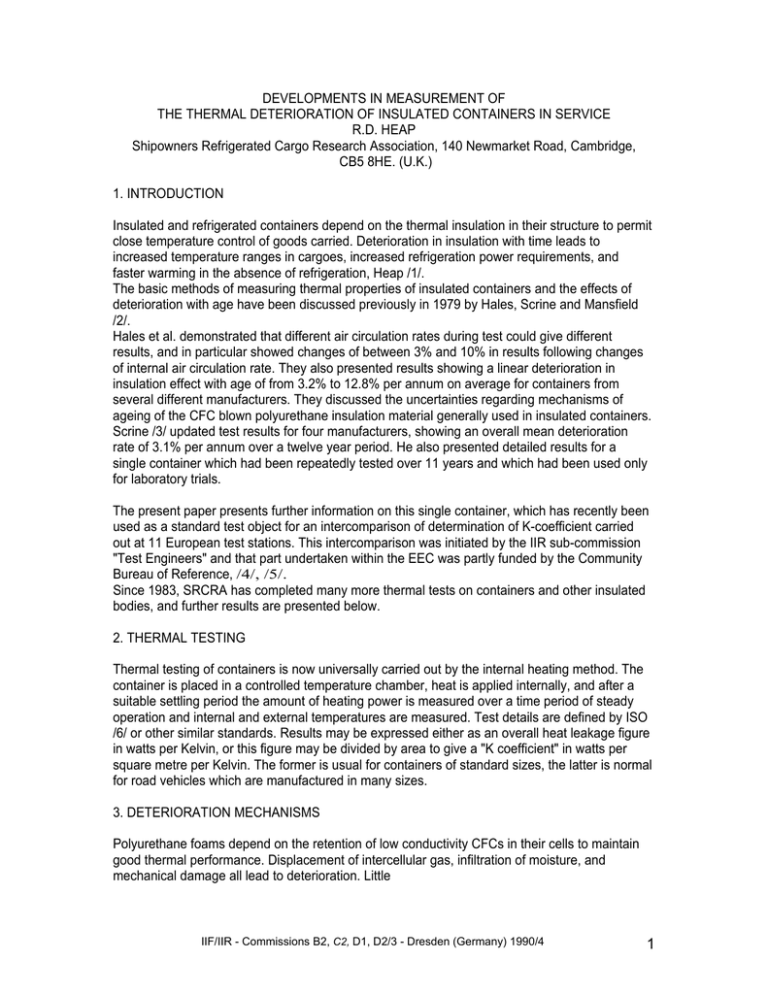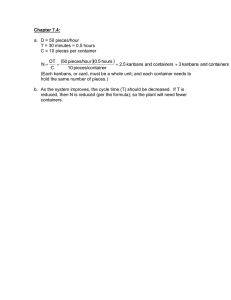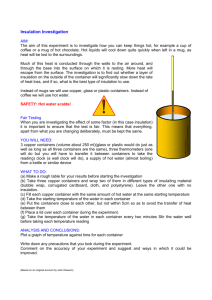Deterioration in insulation - Cambridge Refrigeration Technology
advertisement

DEVELOPMENTS IN MEASUREMENT OF THE THERMAL DETERIORATION OF INSULATED CONTAINERS IN SERVICE R.D. HEAP Shipowners Refrigerated Cargo Research Association, 140 Newmarket Road, Cambridge, CB5 8HE. (U.K.) 1. INTRODUCTION Insulated and refrigerated containers depend on the thermal insulation in their structure to permit close temperature control of goods carried. Deterioration in insulation with time leads to increased temperature ranges in cargoes, increased refrigeration power requirements, and faster warming in the absence of refrigeration, Heap /1/. The basic methods of measuring thermal properties of insulated containers and the effects of deterioration with age have been discussed previously in 1979 by Hales, Scrine and Mansfield /2/. Hales et al. demonstrated that different air circulation rates during test could give different results, and in particular showed changes of between 3% and 10% in results following changes of internal air circulation rate. They also presented results showing a linear deterioration in insulation effect with age of from 3.2% to 12.8% per annum on average for containers from several different manufacturers. They discussed the uncertainties regarding mechanisms of ageing of the CFC blown polyurethane insulation material generally used in insulated containers. Scrine /3/ updated test results for four manufacturers, showing an overall mean deterioration rate of 3.1% per annum over a twelve year period. He also presented detailed results for a single container which had been repeatedly tested over 11 years and which had been used only for laboratory trials. The present paper presents further information on this single container, which has recently been used as a standard test object for an intercomparison of determination of K-coefficient carried out at 11 European test stations. This intercomparison was initiated by the IIR sub-commission "Test Engineers" and that part undertaken within the EEC was partly funded by the Community Bureau of Reference, /4/, /5/. Since 1983, SRCRA has completed many more thermal tests on containers and other insulated bodies, and further results are presented below. 2. THERMAL TESTING Thermal testing of containers is now universally carried out by the internal heating method. The container is placed in a controlled temperature chamber, heat is applied internally, and after a suitable settling period the amount of heating power is measured over a time period of steady operation and internal and external temperatures are measured. Test details are defined by ISO /6/ or other similar standards. Results may be expressed either as an overall heat leakage figure in watts per Kelvin, or this figure may be divided by area to give a "K coefficient" in watts per square metre per Kelvin. The former is usual for containers of standard sizes, the latter is normal for road vehicles which are manufactured in many sizes. 3. DETERIORATION MECHANISMS Polyurethane foams depend on the retention of low conductivity CFCs in their cells to maintain good thermal performance. Displacement of intercellular gas, infiltration of moisture, and mechanical damage all lead to deterioration. Little IIF/IIR - Commissions B2, C2, D1, D2/3 - Dresden (Germany) 1990/4 1 work has been done to investigate these mechanisms in full size insulated structures, and the questions raised by Hales et al. in 1979 remain largely unanswered. SRCRA has sought, and failed to find, a correlation between container insulation deterioration and container weight (due to moisture ingress). Current studies on scrapped containers suggest a CFC retention of at least 50% of original values after 18 years, but only a very limited range of samples has been examined to date. The understanding of deterioration mechanisms is crucial to the acceptance of CFC reduced and HFC/C02 blown foams which are being proposed for the future, in order to reduce use of "ozone - unfriendly" CFCs, /7/. Existing materials are evidently commercially useable for over 15 years, and substitutes must be the same. 4. "TEST" CONTAINER RESULTS The specific container reported by Scrine /3/ in 1983 has now been tested regularly over a period of 18.5 years. It was manufactured in February 1971 and has been used by SRCRA since that date. New door seals and temporary "porthole" plugs were fitted in 1989 prior to the European "Tour". The results of SRCRA's tests are shown in Figure 1, as overall heat leakage figures at a standard mean wall temperature of 10°C. Error 'bars' of ± 2% indicate the likely range of testing variations. It appears that the rate of deterioration was approximately linear with time for about 12 years, with little change over the last 6 years. These results will be of interest to those studying mechanisms of ageing, and also to those involved in the European intercomparison tests. IIF/IIR - Commissions B2, C2, D1, D2/3 - Dresden (Germany) 1990/4 2 It is well known that the thermal conductivity of insulation materials varies with temperature. The extent of this variation for one particular container (not that referred to in section 4 above) is shown in Figure 2. This container was tested successively at seven different mean wall temperatures, with all other test variables held constant (i.e. constant equipment, constant airflows, constant "delta T"). The order of testing is shown in the Figure, to demonstrate that there were no changes (e.g. moisture content) to provide a drift of results with time. The container was a newly refurbished nine year old unit. All the results fall within 1% of the regression line, demonstrating good test reproducibility Fig. 2 Sequence of heat leak tests on one container The effects of mean wall temperature (mwt) on test results may be allowed for by testing at two different mwts and extrapolating. This is a generally reliable method. Alternatively, a single test result may be "corrected" using a standard formula. Such a formula is given by the TTMA /8/ for polyurethane foams· of density 25 to 40 kg/m3, and this formula may be expressed as: K (T1)= T1 + 170 ------------- X K (T2) T2 + 170 where T1 , T2 are temperatures expressed in °C and K (T1), K (T2) are heat leakage results at these temperatures. IIF/IIR - Commissions B2, C2, D1, D2/3 - Dresden (Germany) 1990/4 3 A series of calculations has been carried out using this formula, to determine the errors introduced in using it to obtain results at T1 = 10°C from tests at T2 from 19°C to 23°C. Two series of test results were used, one relating to 16 heavily insulated containers and another relating to 10 lightly insulated containers ("fruit boxes"). Results are shown in Table I. TABLE 1 Extrapolation errors, using tests at 19 to 23°C mean wall temperature to obtain data for lOoC mean wall temperature No. of units tested Age of units, years Mean heat leakage, W/K (at 10°C m.w.t.) Errors from extrapolation:mean error mean /error/ maximum errors 16 9 to 12 34.7 10 10 to 12 41.1 +0.3% 1.67% +3.2% ,-3.2% -0.4% 1.49% +2.4%, -3:4% It is seen that the formula is accurate on average, but can be in error by over 3% for any particular unit. This error is proportional to the difference between T1 and T2. The 3% error in a correction of 10°C increases to 6% if the test is corrected to a temperature 20°C from that at which the test was carried out. 6. NEW DATA ON DETERIORATION Four groups of tests have been completed on heavily insulated containers from two manufacturers, all the containers being between 10 and 12 years old at time of test. Results obtained, and mean annual deterioration rate based on manufacturers prototype results, are summarised in Table II. TABLE II Thermal deterioration of heavily insulated containers No. of units tested 6 7 12 5 6 Manufacturer Age at test, years Mean heat leak, W/K (at 10°C m.w.t.) Mean annual deterioration, % p.a. I 10.5 I 11.5 I 10 II 10.2 I 10.5 29.7 3.76 30.3 3.67 33.1 5.54 31.2 4.60 29.7 3.76 The overall deterioration rates are a little higher than those reported by Scrine. This may be due to greater in-service damage in older container-s, or may be due to use of non-representative original samples in calculating deterioration. Detailed comparison of results with Scrine's suggests a combination of both of these factors. This points to the future value of a representative number of tests being carried out on new containers if deterioration is to be assessed later. Two further groups of lightly insulated containers have been tested, with results shown in Table Ill. These results are consistent with other results on this type of container over the years, and show a mean deterioration rate appreciably less, in percentage terms, than that found for heavily insulated containers. IIF/IIR - Commissions B2, C2, D1, D2/3 - Dresden (Germany) 1990/4 4 For both types of container, in these tests, the overall deter-ioration is approximately 0.9 watts per Kelvin per year regardless of insulation thickness. All the above results relate to '20 foot' containers. SRCRA has gathered no information on the deterioration of '40 foot' containers with time TABLE III Thermal deterioration of lightly insulated containers No. of units tested Manufacturer Age at test, years Mean heat leak, W/K (at 10°C m.w.t.) Mean annual deterioration, % 6 11 47.9 6 II 10.2 44.3 1.88 2.59 III 7. APPLICATION OF RESULTS TO M.C.O.U.s Mechanical clip-on refrigeration units (m.c.o.u.s) are used with insulated containers, either during transport or at terminals, and several operators have been replacing m.c.o.u.s recently, using the much-improved machines which are now available from several manufacturers. The effects of air circulation from m.c.o.u.s on thermal test results on container/m.c.o.u. combinations have been examined. For a typical heavily insulated container of 23 W/K heat leak at 10°C m.w.t., the overall heat leakage of the combination is increased to about 28 W/K at low fan speed and further increased to about 33 W/K at high fan speed. This means that considerable care is necessary in formulating equipment specifications based on standard heat leakage tests and on calorimeter tests of refrigeration unit capacity. Problems can be introduced by ignoring the additional heat leakage of the m.c.o.u. itself, or by failing to appreciate the effect of air circulation rate on heat leakage. Methods of test need careful specification if valid comparisons are to be made between units. 8. CONCLUSIONS The effects of variables such as temperature and air circulation rate on thermal testing are now well known, and results are available showing the rates of deterioration of existing insulated 20 foot containers with both heavy and light insulation. However, deterioration mechanisms still require further study. With the introduction of new foam materials to reduce CFC use, it is important that deterioration characteristics are established for new foams, if confidence in the long-term effectiveness of the new materials is to be established. REFERENCES 1. 2. 3. 4. R.D. HEAP (1989). Design and performance of insulated and refrigerated ISO intermodal containers. Int.J.Refrig., Vol. 12, 137-145. K.C. HALES, G.R. SCRINE & J.E. MANSFIELD (1978-79). Thermal testing of insulated vehicles. Proc. Inst. Refrig. Vol. 75 pp 55-64. G.R. SCRINE. Further aspects of insulation deterioration. IIR XVlth Congress of Refrigeration (Paris 1983) Proceedings, Vol. IV, Pp 557-563. IIR Report in preparation. IIF/IIR - Commissions B2, C2, D1, D2/3 - Dresden (Germany) 1990/4 5 5. 6. 7. 8. 10. EEC Report in preparation. ISO standard ISO 1496/II·, Thermal containers (1988). M. JEFFS (1989). Foam performance: thicker walls or even larger compressors? Reefer Trans 89 Conference Synopses, 153-155. Cargo Systems, London. TTMA (1983). RP No. 38-73. Method for rating heat transmission of refrigerated vehicles. Truck and Trailer Manufacturers Association. , DISCUSSION GRINZATO, E. (Italy) - Do you think that the ageing process works homogeneously or could be localized in critical points like joints, doors, seal and so on ? HEAP, RD. - There are two mechanisms of ageing, there is a gradual, homogeneous process relating to the foam material, and there is also the effect of moisture entry through damage and cleaning, this latter effect will be localized and may often result in excess floor deterioration. BENNAHMIAS, R. (France) - Le conteneur utilise pour les essais interlaboratoires, et qui a fait I'objet d'une etude de vieillissement que vous avez presentee, a-t-il subi des chocs mecaniques d'exploitation (normale),ou bien a-t-il vieilli uniquement a cause des chocs thermiques, par une mise en temperature du conteneur entre chaque essai de vieillissement ? HEAP, RD. - This particular container has been subjected to occasional thermal shocks in the course of experiments, but has not been liable to the full rigours of commercial operation. Its deterioration therefore represents a "best case" example. MEFFERT, H.F.Th. (Netherlands) - In ageing experiments with sandwich elements, we found that the ageing-coefficient is depending on the mean wall temperature. Ag. 1 of your paper shows the situation for 10°C m.w.t. Can you indicate the course of the ageing curve for higher temperatures? M.w.t. of 10°C requires a cooling method for the K-value measurement. HEAP, RD. - For measurements at 20°C m.w.t. all the results will be approximately 5 % higher than those shown in Fig. 1. This temperature is, of course, the temperature at which heat leakage is measured, and does not relate to the temperature at which the container has been aged. We always use the internal heating method for K-vaIue measurement, and have no difficulty in obtaining results at mean wall temperatures down to 0°C, using a suitable test chamber with sufficient cooling capacity to reduce the ambient temperature around the container to -10°C. IIF/IIR - Commissions B2, C2, D1, D2/3 - Dresden (Germany) 1990/4 6




